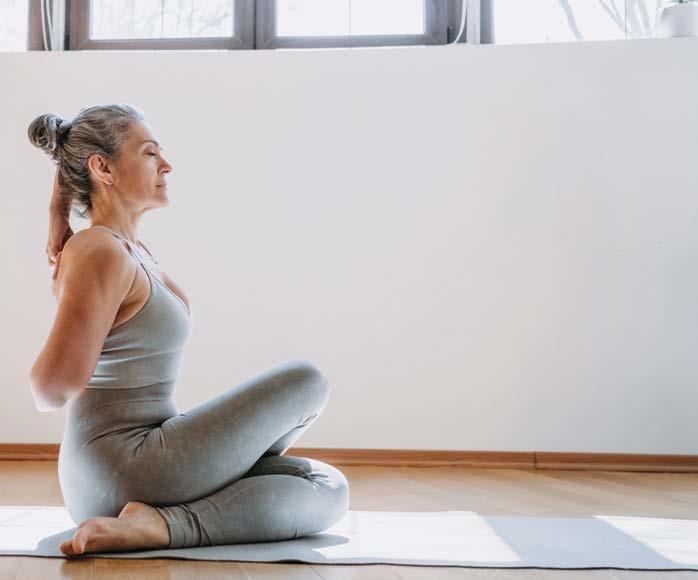
3 minute read
Maintain flexibility as you age ............ Jonnemarie Kahwaty
The home stretch
Maintain flexibility as you age
BY JONNEMARIE KAHWATY
What do you think when you hear “stretching and flexibility?” Do you cringe at the thought of trying to touch your toes? Do you picture people twisting themselves into pretzels or think “that’s just not my thing?” Despite popular belief, flexibility is not just for yogis and athletes. It’s one of the three components of fitness— cardiovascular and strength training are the other two—and is a critical part of health maintenance at any age, but especially for seniors who can expect to lose twenty-five to thirty percent of their flexibility by age seventy.
The benefits of stretching are myriad. Stretching not only supports and improves flexibility (the ability of your muscle groups to lengthen passively through a range of motion), but also mobility (the ability of a joint to move actively through a range of motion). It’s commonly thought that flexibility and mobility are the same thing, so here’s an exercise you can do to understand the difference. Extend your arm in front of you with palm facing up and use your other hand to push your fingers down from the wrist as far as you can comfortably. Now let go. Your hand probably came up a little bit, right? The range in the assisted stretch demonstrates the flexibility of your wrist, while the unassisted bend demonstrates wrist mobility. Why is all of this important to overall health and daily function? As you saw with that wrist exercise, the better your flexibility and mobility are, the easier it is for you to move your body. As we get older, muscles weaken and tighten, which decreases our range of motion. That makes it harder for us to do everyday tasks like reaching for things on a high shelf or even bending over to tie shoes. Consistent stretching improves circulation and keeps muscles and joints from stiffening. That means you’ll use less energy completing daily movements and be at lower risk of injuring yourself doing them. It also improves stability and balance, which are key to preventing falls, an increasing danger as we age. Muscle tension is also a common cause of pain. Have you ever felt pain after sitting too long in one position? How about after moving too much? Stretching can help in both scenarios! Stretching a muscle that’s been overworked or overused will boost blood flow and help that muscle heal more quickly. Stretching a muscle that has been stuck in one position for a long time provides relief by allowing it to relax and lengthen. So next time something hurts, instead of reaching for painkillers, do your body a favor and try stretching it out first.
An important caveat: never stretch without warming up. Stretching cold muscles is not only less effective but can also lead to injury because the muscles are stiff. Warming up your body with dynamic movement—arm circles, controlled leg swings, a short walk, or even marching in place—wakes up your nerves, increases blood flow, and encourages elasticity in your muscles so they are more prepared to stretch.
Stretching should never be forced. When you assume a position, find the point where you feel a stretch without pain or discomfort. Don’t try to push past that point as it can lead to injury. Instead, move slowly into a stretch and avoid jerky movements or bouncing. Once you reach a comfortable point, hold that position for at least fifteen to thirty seconds. Breathe in and out slowly and allow your body to relax into the stretch.
A daily stretching practice is ideal but aim for three to five times a week. Look up specific stretches for certain muscles, or just do what feels good. Remember, this should not be painful. You’re relaxing your muscles, not working them!
Talk to your doctor before starting a new stretching routine, especially if you have underlying health conditions or are recovering from surgery or injury. Start slowly and respect your body’s limits. As time goes on, your flexibility and mobility will increase, and you may also notice improvements in posture, mood, and energy—all of which will boost your quality of life. FY
Jonnemarie Kahwaty is a dance instructor, musician, and aspiring herbalist with a passion for holistic health and wellness.






